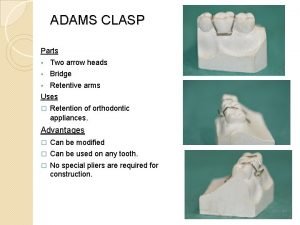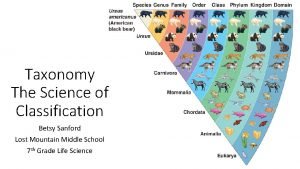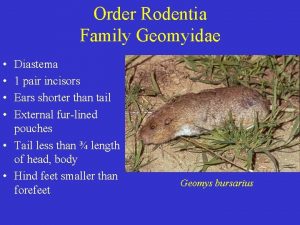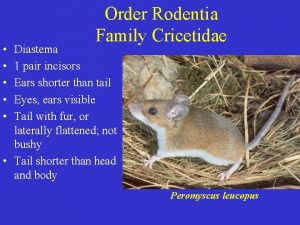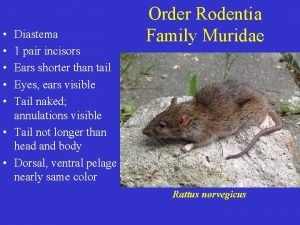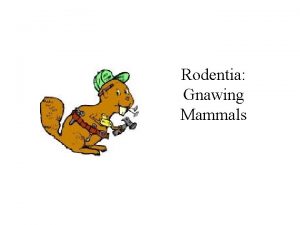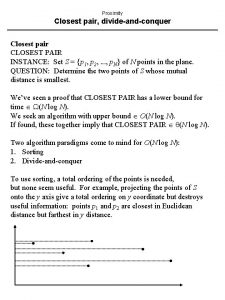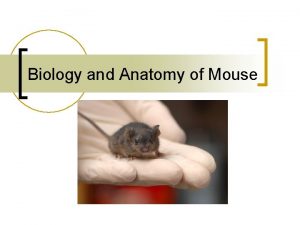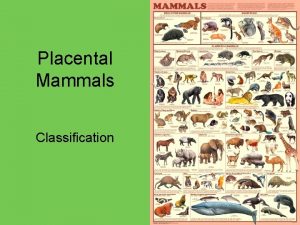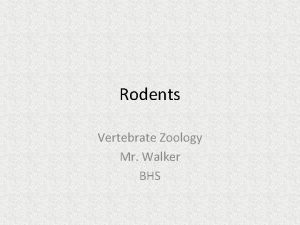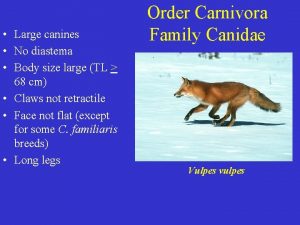Order Rodentia Family Geomyidae Diastema 1 pair incisors




















- Slides: 20

Order Rodentia Family Geomyidae • • Diastema 1 pair incisors Ears shorter than tail External fur-lined pouches • Tail less than ¾ length of head, body • Hind feet smaller than forefeet Geomys bursarius

Order Rodentia Family Heteromyidae • • Diastema 1 pair incisors Ears shorter than tail External fur-lined pouches • Tail more than ¾ length of head, body • Hind feet larger than forefeet Perognathus flavescens

Perognathus flavescens Identification: Dorsum cinnamon with blackish hairs; venter lighter; lightcolored patch behind ears and around eyes Distribution: West (Loess Hills), southeast, central Iowa Habitat: Grassy slopes; well drained; small burrows

Perognathus flavescens Diet: Seeds of grasses, other herbs Reproduction: 2 -3 litters of 38 annually Conservation: Endangered; several isolated populations

Order Rodentia Family Castoridae • • • Diastema 1 pair incisors Ears shorter than tail Hind feet webbed Tail scaly, paddleshaped Castor canadensis

Castor canadensis Common name: Beaver • Order Rodentia – Family Castoridae • Genus Castor – Species Castor canadensis http: //www. inhs. uiuc. edu/dnr/fur/species/beaver. html Presented by Catherine Luria

Castor canadensis Identification • Largest rodent in Iowa • TL 94 -120 cm; tail, 23 -37 cm; hind foot, 17 -19 cm; ear, 30 -35 mm • Usually weighs 15 -30 kg, up to 45 kg http: //www. inhs. uiuc. edu/dnr/fur/species/beaver. html

Castor canadensis Distribution • Much of North America from central Alaska and Northern Canada to Northern Mexico • Found throughout Iowa and north-central United States http: //www. huntington. edu/thornhill/images/wildlifephotos/beaver. jpg

Castor canadensis Habitat • Streams, rivers, marshes, and lakes • Often near willow, aspen, and other preferred food sources http: //www. huntington. edu/thornhill/images/wildlifephotos/beaver. jpg

Castor canadensis Diet • Summer: grasses, leaves, roots of aquatic plants, bark stripped from building materials, sometimes berries • Winter: leaves and inner bark of stored saplings and branches • Prefers willow, aspen, cottonwood, alder; tends to avoid pine except for building www. wildflorida. org/ critters/beaver. asp

Castor canadensis Diet • Stores food for winter by anchoring branches and saplings to bottom of pool • “Feed pile” is 3 -6 feet deep and up to 30 -40 feet wide • Beaver leaves den through underwater entrance, gets food from the pile, and returns to the den www. occdsb. on. ca/ ~sel/rideau/beaver. htm

Castor canadensis Reproduction • Breeding starts in January of February • Female bears 1 -6 kits (usually 3 -4) in April, May, or June • Young are weaned in 6 weeks but will stay with family group 1 -2 years

Castor canadensis Reproduction • Family groups consist of around 12 beavers – One or more pairs of adults – Young of that year – Yearlings • Yearlings leave or • are driven off as • kits mature

Castor canadensis Conservation Status • Valuable pelt • Once trapped to extinction in some areas • Protective legislation and natural emigration have allowed beaver to reoccupy much of its former range • Now fairly common, even considered a pest in some areas http: //www. wildernessclassroom. com/w ww/schoolhouse/boreal_library/animals/ photos/beaver. jpg

Castor canadensis Disease • Can carry rabies • Carries tularemaia – Bacterial infection – Transmitted to humans through contact with beaver tissue or blood or through contaminated water – Causes headache, fever, chills, vomiting, aches and pains http: //www. wildernessclassroom. com/ww w/schoolhouse/boreal_library/animals/pho tos/beaver. jpg

Castor canadensis Dam building • Dams constructed of branches, rocks, leaves, and other debris and filled with mud from the stream bottom • 4 -7 feet across • Added to as water level rises • Smaller dams are sometimes constructed to relieve pressure on http: //www. exzooberance. com/virtual%20 zoo/they%20 s main dam wim/beaver/Beaver%20485050. jpg

Castor canadensis Why do beavers build dams? • Increases the depth and surface area of the stream or pond http: //www. bfro. net/avevid/nelson/images/beaver%20 dam. jpg – Easier to drag branches, etc. – Prevents the underwater entrance to the den or lodge from freezing over – Protects against predation – Allows greater access to food

Castor canadensis Beaver Lodges • Built against the back of the den or against the stream bank • Dome-like structure built of sticks and mud • Underwater entrance(s) http: //www. saskschools. ca/~gregory/animals/images/bvr 2. jpg

Castor canadensis Other • Primarily nocturnal/crepuscular • Presence easily detected by chewed saplings • Little predation: mink take young and large carnivores may attack adults

References Illinois Department of Natural Resources. Ecology and Conservation of Illinois’ Fur Resources. http: //www. inhs. uiuc. edu/dnr/fur/index. html Iowa Association of Naturalists. Iowa Mammals. http: //www. extension. iastate. edu/publications/ian 601. pdf Jones, J. Knox, Jr. and Elmer C. Birney. 1988. Handbook of Mammals of the North-Central States. University of Minnesota Press, Minneapolis. Kays, Roland W. and Don E. Wilson. 2002. Mammals of North America. Princeton University Press, Princeton, NJ.
 Diastema in cows
Diastema in cows Monkey diastema
Monkey diastema Milana karaganis
Milana karaganis Functions of incisor
Functions of incisor Mills labial bow
Mills labial bow 25 cm from incisors
25 cm from incisors Gj mount classification of dental caries
Gj mount classification of dental caries Maxillary central incisor characteristics
Maxillary central incisor characteristics Ordered pair and unordered pair
Ordered pair and unordered pair Dof of screw pair
Dof of screw pair Via optica
Via optica Conjugal family
Conjugal family Varies from family to family on the periodic table
Varies from family to family on the periodic table Blended family vs binuclear
Blended family vs binuclear Third order cybernetics
Third order cybernetics Is the science of naming and classifying organisms
Is the science of naming and classifying organisms Classification study guide answer key
Classification study guide answer key Class order family
Class order family Order of plant classification
Order of plant classification Family genus species order
Family genus species order Categories of living things
Categories of living things




